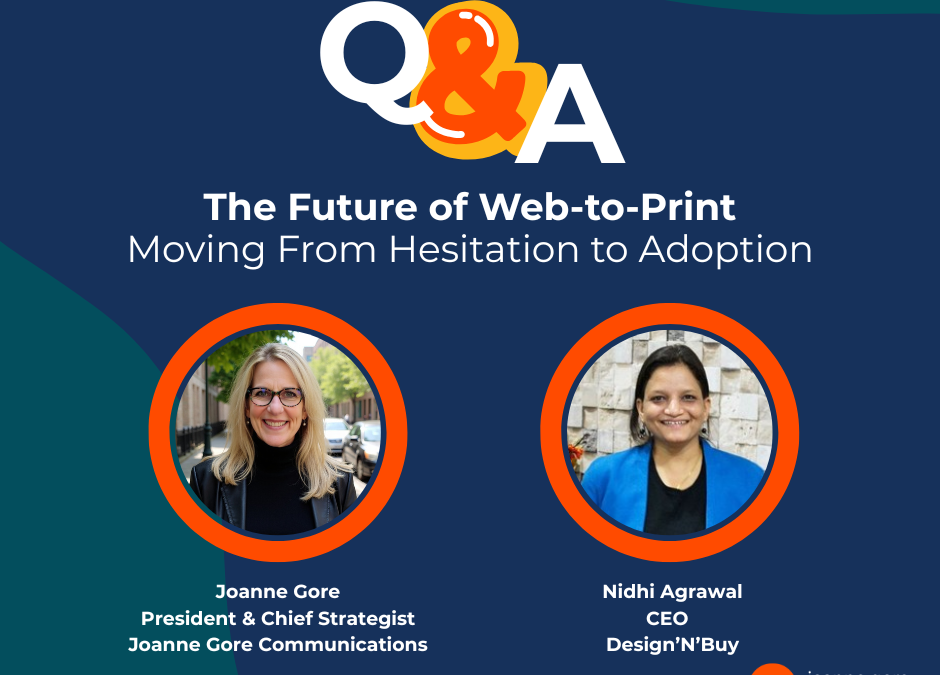The Future of Web-to-Print: Moving from Hesitation to Adoption
Commercial printers know that buyers expect fast ordering, clear communication, and the convenience of self-service. While Web-to-Print, or Web-to-Anything, supports the shift and enables customers to design, review, and purchase online with minimal friction – many printers hesitate to adopt an eCommerce mindset.
The hesitation is rarely about technology alone.
To explore this, Joanne Gore Communications’ President and Chief Strategist, Joanne Gore, sat down with Nidhi Agrawal, Co-Founder of DesignNBuy, to discuss hesitation, integration, AI, and how to introduce a storefront that customers will actually use.
Question 1: Printers often hesitate when considering a Web-to-Print storefront. What do you hear most and why?
Answer: Nidhi
Many assume new technology brings risk. She notes the greater risk is standing still especially when buyer needs are changing. Printers who describe the first time they woke to an overnight order, fully automated, quickly understand the upside.
Cost becomes part of the discussion later. Most begin by evaluating whether a platform integrates with MIS, ERP, or production workflows. Every platform sounds similar, but each has different strengths. For many, this creates overwhelm.
Common concerns include:
- Lack of internal knowledge
- Integration barriers
- Uncertainty about ROI
- Training requirements
- Customer onboarding
Adoption requires more than software; it demands team participation and realistic expectations. The first six months often bring fewer manual checks and stronger workflow confidence.
Question 2: How should printers prepare before their Web-to-Print Store goes live?
Answer: Nidhi
Start with goals. Ask what the business wants to achieve. Examples include:
- Faster order processing
- 24/7 self-service
- Stronger Personalization
- Better personalizationFrom there, identify internal champions. W2P is not self-running; success depends on people who understand pricing, templates, shipping, and customer support expectations.
Once aligned on goals and resources, define KPIs such as:
- Turnaround time
- Volume per customer
- Time saved per order
- Reduction in checkpoints
Nidhi recommends starting small rolling out to a limited set of trusted customers, gathering feedback, refining workflows, then expanding.
Joanne notes that printers are often surprised by the number of decisions required: banking tools, shipping providers, security, and payment gateways. These directly impact speed and trust and must be mapped and tested early.
Question 3: What happens after the Web-to-Print storefront is built?
Answer: Joanne
This is where many stumble. They build the storefront, switch it on, and expect traffic. Then they assume customers aren’t interested.Marketing is critical. Customers must understand the value and how it fits their workflow. Buyers think like ecommerce shoppers, not W2P specialists, so messaging must match their language and priorities.
JGC helps printers:
- Develop targeted marketing plans
- Create content that communicates storefront value
- Build ICP-based prospecting lists
- Identify near-term buyers
- Craft nurturing campaigns with consistent messaging
Nidhi also adds an important perspective: ROI is not linear. Short-term outcomes (6–12 months) differ from longer-term gains (5–10 years), including stickier customer relationships and more predictable revenue streams.
Question 4: Can you share a practical example of a Web-to-Print store using AI to improve customer service?
Answer: Nidhi
A last-minute banner request illustrates how W2P and AI streamline ordering. Instead of calling a rep, requesting pricing, submitting artwork, and reviewing proofs, a customer can provide a simple prompt, for example:- pink colour
- balloons in the background
- ribbons
- birthday message
The system generates artwork and text automatically, letting customers finalize purchases in minutes. This removes friction and encourages repeat business especially among time-strapped users.
Online tools have changed buying behaviours as customers research independently – and convenience and speed drive decisions. They buy when they’re ready, with W2P supporting that reality. For example, on-demand AI-generated banners illustrate W2P’s immediacy: customers describe what they want, systems produce artwork options, and transactions complete with minimal human involvement. The result: reduced pressure on sales teams and shorter order cycles.
Implementation is not the finish line. Commercial printers that prepare thoroughly and communicate clearly have the best opportunity to see meaningful adoption. Promotion, onboarding, and ongoing messaging are essential. Internal advocates and a clear plan transform a storefront into a durable business asset.
Adopting Web-to-Print is a strategic shift in how printers engage customers and manage workflows. By understanding buyer behaviours, leveraging AI tools, and supporting customers with an intuitive, well-communicated storefront, printers can reduce friction, encourage repeat business, and unlock long-term value.
Watch the podcast in full on YouTube here.




